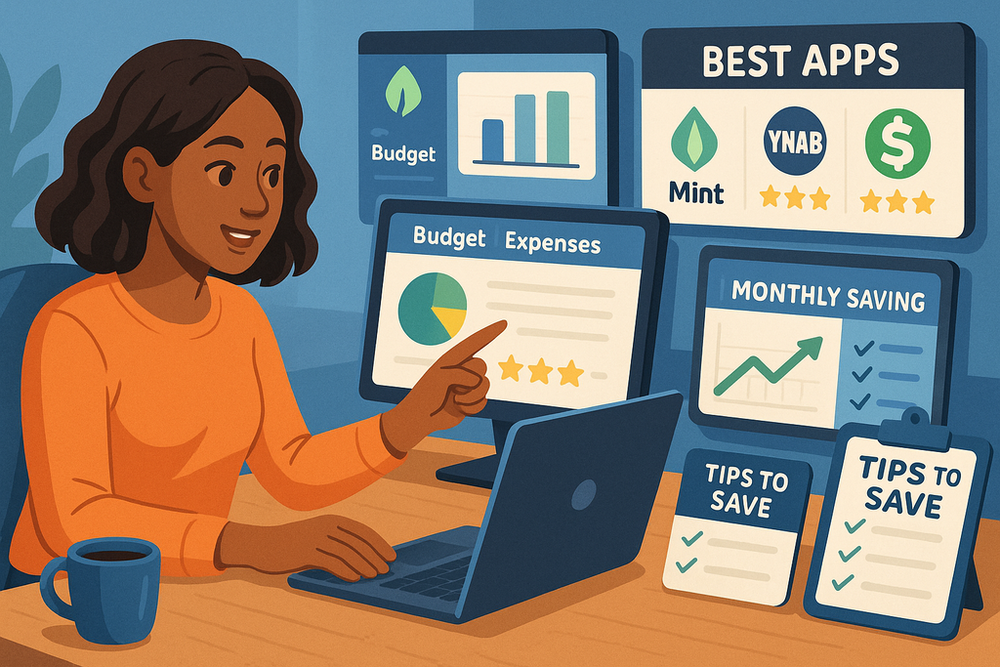Table of Contents
The best way to save money often feels out of reach when you’re living on a low income. How do you cover rent, bills, groceries, and still manage to put something aside? Is it even realistic to save on a tight budget?
This guide breaks down practical and proven ways to make saving money possible each month, even when every dollar counts.
Track Every Expense To Find Hidden Savings
When money feels like it disappears before the month is even over, tracking every dollar is the first step toward taking control. You can’t fix what you can’t see, and sometimes the biggest leaks in your budget aren’t obvious until you write them down.
Use Budgeting Apps To Simplify Tracking
Budgeting apps are lifesavers if you don’t like the idea of keeping a notebook. Tools like Mint, YNAB (You Need A Budget), or even the free EveryDollar app connect to your bank account and automatically categorize your expenses.
Here’s how it usually works:
- Download the app and link your checking account or debit card.
- The app pulls in your purchases, labeling things like “Groceries,” “Utilities,” or “Restaurants.”
- You can see at a glance where most of your money is flowing.
For example, when I tried this, I discovered I was spending nearly $60 a month just on small coffee shop visits. That’s $720 a year without even realizing it. Having the numbers right in front of you makes it easier to decide what’s worth keeping and what you can cut.
If you don’t want to link accounts, most apps let you add expenses manually. It takes a little more effort, but it gives you full control over your categories.
Write Down Daily Purchases For Awareness
Sometimes going old-school works better than fancy apps. A simple notebook or a notes app on your phone can help you jot down every single purchase, no matter how small.
Here’s a system I recommend:
- Keep a small notepad in your bag or use your phone’s notes app.
- Write down the date, what you bought, and the amount.
- At the end of the week, add it up and see where the money went.
This method builds awareness because writing something down makes you think twice before spending. It’s almost like having to “confess” your purchase to yourself. Even $2 here or $5 there starts to show up as a real pattern when you add it all up.
Spot Spending Habits That Drain Your Wallet
Once you track expenses for a few weeks, patterns start to pop out. Maybe it’s eating out twice a week. Maybe it’s gas from driving back and forth on extra errands. Or maybe, like me at one point, it’s late-night Amazon purchases that felt cheap individually but stacked up quickly.
The point isn’t to shame yourself but to spot the leaks. Think of it like a detective game—you’re looking for the “suspects” stealing your money quietly. Once you know, you can decide what to cut or replace with cheaper alternatives.
The hidden benefit here is mental clarity. When you see your habits clearly, you stop feeling like money “just disappears.” You know exactly where it’s going, and that’s empowering.
Cut Monthly Bills Without Sacrificing Essentials
Lowering your monthly bills doesn’t mean giving up comfort. It’s about getting smarter with the services you already use. Many companies count on you not paying attention, which means they quietly raise rates or charge you for things you barely use.
Negotiate Lower Rates On Utilities And Internet
You’d be surprised how often providers will lower your bill if you just ask. I once shaved $20 a month off my internet bill with a single phone call.
Here’s a simple script you can use:
- Call your provider’s customer service.
- Say something like, “I’ve been a loyal customer, but my bill is too high. Do you have any promotions or discounts available?”
- If they say no, mention that you’re considering switching to another provider.
Suddenly, you’ll often find they “discover” a cheaper plan. The same works with cable, electricity, and even insurance companies.
Switch To Prepaid Plans For Phone Savings
Phone bills are notorious for creeping up. Prepaid plans from companies like Mint Mobile, Visible, or Cricket Wireless often cost half of what the big carriers charge.
For example, Mint Mobile offers unlimited talk, text, and data for around $30/month if you pay upfront. Compare that to $70 or more on a traditional contract, and that’s $480 in savings per year.
The best part? You still use the same networks (like T-Mobile or Verizon), so the service quality is often identical.
Cancel Subscriptions You Rarely Use
Streaming services, apps, and memberships sneak into your budget and stay there. A $10 subscription might not feel like much, but three or four of them add up quickly.
Go through your bank statements and highlight every recurring charge. Ask yourself:
- Did I use this in the past month?
- Do I really need both Netflix and Hulu right now?
- Could I rotate subscriptions instead of paying for all at once?
Rotating is my favorite hack. Watch what you want on Netflix for a couple of months, then cancel and switch to another service. You’ll always have something fresh to watch without paying for multiple subscriptions at once.
Save Money On Groceries Without Feeling Deprived
Groceries are one of the biggest expenses for most households. The good news is, you can cut this bill significantly without eating noodles every night.
Plan Meals Around Weekly Discounts
Most grocery stores post weekly flyers with sales. Instead of planning meals first and shopping second, flip the script. Check what’s on sale and build your meals around that.
For instance, if chicken thighs are 40% off, that’s your protein for the week. Add rice, beans, and a few vegetables, and you’ve got three or four affordable meals without overspending.
Meal planning not only saves money but also reduces food waste. You’re less likely to throw out forgotten ingredients when every purchase has a plan.
Buy Store Brands Instead Of Name Brands
Here’s the truth: store brands are often made in the same factories as the big-name products. The only difference is the label and the price.
I once did a blind taste test with friends comparing store-brand cereal and the big names. Most of us couldn’t tell the difference, and the price was nearly half. Multiply that across dozens of products, and you’re saving hundreds over a year.
When in doubt, compare unit prices on the shelf tags. Store brands almost always win.
Use Cashback And Rebate Apps For Food Purchases
Cashback apps like Ibotta, Rakuten, and Fetch Rewards turn everyday grocery shopping into an easy way to get money back.
Here’s a quick example with Ibotta:
- Open the app and browse offers (like $1 off a brand of yogurt).
- Shop at your regular store.
- Scan your receipt, and the cashback is added to your account.
I know someone who saves around $20–$40 a month just using these apps. It might not sound huge, but that’s $240–$480 a year—basically a free grocery budget for a month.
Pro tip: Stack these apps with store loyalty cards and digital coupons. It’s like creating a triple-layer safety net for your grocery budget.
Create An Emergency Fund With Small Steps
When you’re living on a low income, the idea of an emergency fund can feel almost laughable. But here’s the truth: you don’t need thousands of dollars sitting in the bank to get started.
Even a tiny cushion can prevent a financial crisis from spiraling. Think of it like building a brick wall—one brick at a time still creates something strong.
Start With Just A Few Dollars Weekly
I believe the trick is to start ridiculously small. If you can set aside even $5 a week, that’s $260 by the end of the year. That may not sound like much, but it covers a surprise bill, a prescription, or a blown tire—things that usually throw you off track.
One approach that worked for me was using “found money.” Whenever I had spare change, a $1 bill in my wallet, or cash from returning recyclables, it went straight into a jar. Watching that jar fill up built momentum and made saving feel less like a chore.
The key is consistency, not size. Saving $5 each week beats waiting until you can save $50 and never starting.
Open A Separate Savings Account For Discipline
It’s tempting to dip into your savings if it’s sitting in the same account as your spending money. That’s why I suggest opening a separate savings account—preferably at a different bank or an online bank where the money isn’t right in front of you.
Here’s how I set it up:
- Log into your bank’s website or app.
- Look for “Open a New Account.” Many banks let you open a free savings account in minutes.
- Nickname it something motivating, like “Emergency Cushion” instead of just “Savings.”
Some online banks like Ally or Capital One let you create “buckets” inside your savings account. You could label one bucket “Emergency Fund” and another “Car Repairs,” so your money always has a job.
This little barrier—having to transfer money back before you can spend it—stops you from raiding your savings for non-essentials.
Automate Small Transfers To Build Consistency
Automation is your secret weapon. When money moves automatically, you don’t have to rely on willpower. Most banks let you set up recurring transfers.
For example, you could schedule $10 every Friday to move from checking to savings. It feels tiny, but that’s $520 over the course of a year—without you lifting a finger.
In my case, I set up an auto-transfer the same day my paycheck landed. That way, I didn’t “feel” the money was ever mine to spend. Even if you automate just $5 a week, the habit is what matters most.
An emergency fund isn’t built overnight—it’s built in layers. But once you have even $200 saved, you’ll feel lighter knowing you’re not one flat tire away from financial stress.
Rethink Transportation To Reduce Monthly Costs
Transportation can quietly eat up a huge chunk of your budget. Between gas, maintenance, insurance, and parking, cars can feel like money vacuums. Rethinking how you get around is one of the best ways to save money each month.
Carpool Or Share Rides With Coworkers
If you commute to work, ask around to see if anyone nearby wants to carpool. Splitting gas and parking fees instantly cuts your costs in half (or more if you rotate between several people).
I once rode with a coworker three times a week, and it cut my gas bill by about $80 per month. Plus, the time chatting during the drive made the commute feel shorter.
If coworkers aren’t an option, check local Facebook groups or apps like Waze Carpool, which connect drivers going the same route.
Use Public Transit Instead Of Driving Daily
I know not every city has great public transit, but where it exists, it can save serious cash. Let’s do the math:
- Driving 15 miles a day at 25 MPG with gas at $3.50 = about $63 per month just in fuel.
- Add insurance, oil changes, and wear and tear, and the true cost is closer to $300–$400 monthly.
- A bus or train pass in many cities costs $70–$100 a month, which is way cheaper.
Even if you only use transit a few days a week and drive the rest, you’ll cut gas and parking expenses significantly.
Walk Or Bike Short Distances To Save Gas
Here’s the underrated hack: swap short car trips for walking or biking. Studies show that nearly 40% of car trips in the U.S. are under 2 miles. That’s walkable or bikeable for most people.
Walking to the store or biking to a friend’s place saves gas, reduces wear on your car, and gives you free exercise. I once calculated that biking just twice a week to run errands saved me nearly $30 a month in gas—and I felt healthier too.
Think of it as stacking benefits: less money spent, less stress from traffic, and more fresh air in your day.
Adopt A Cash-Only Spending System
One of the sneakiest budget killers is plastic—credit and debit cards make it too easy to overspend. Switching to a cash-only system, even just for daily spending, forces you to slow down and become more intentional.
Use The Envelope Method To Control Spending
Here’s the classic method:
- Take out cash for categories like groceries, gas, and fun money.
- Put the cash into labeled envelopes.
- Once the envelope is empty, you’re done spending in that category until next payday.
I tried this for groceries once and found it surprisingly effective. Physically handing over cash makes you more mindful than swiping a card. It also prevents those “oops” moments when you don’t realize how much you’ve already spent.
Limit Impulse Purchases By Carrying Exact Cash
Impulse buying is harder when you only have the exact amount of cash on hand. Let’s say you budget $40 for a night out—take just $40 in cash, and leave your cards at home.
If you see something shiny at a store, but your wallet only has $10, you’re forced to pause. That pause is powerful. It gives you space to ask, “Do I really need this, or do I just want it right now?”
Prioritize Needs Over Wants With Physical Cash
When you physically separate money for needs (groceries, rent, gas) from wants (eating out, entertainment), it becomes clear what matters most. Cash is tangible—you see it shrinking, unlike numbers on a screen.
I once labeled one envelope “Fun” and another “Groceries.” Watching the fun money disappear faster made me slow down and rethink weekend splurges, while making sure essentials were covered.
Cash isn’t magic—it’s psychology. It grounds you, helps you feel the weight of each purchase, and teaches discipline in a way digital transactions never can.
Pro tip: If going fully cash-only feels too restrictive, try it with just one category, like dining out or personal spending. You’ll still get the benefits without overhauling your whole system at once.
Take Advantage Of Community And Assistance Programs
Sometimes the best way to save money is to use resources that are already there for you. Community programs, government aid, and local organizations exist to help people stretch their budgets—and there’s no shame in using them.
Apply For Food Assistance And Discounted Utilities
If grocery costs are overwhelming, programs like SNAP (food stamps) or local food banks can make a huge difference. I’ve known people who got $100–$200 a month in food assistance, and that completely freed up cash for bills and savings.
For utilities, many states have programs that lower heating, electricity, and water bills for low-income households. Often, it’s as simple as filling out a form on your utility company’s website. For example, I once helped a neighbor apply for a “budget billing” program that cut her electric bill by almost 30%.
The trick is asking. Companies and agencies don’t always advertise these programs loudly.
Use Free Local Events For Entertainment
Entertainment doesn’t need to cost a fortune. Cities and towns often host free events—concerts in the park, outdoor movie nights, library workshops, and festivals.
Instead of paying $40 for a night at the movies, you can bring a blanket, pack snacks, and enjoy a free movie under the stars. Not only does it save money, but it also creates memorable experiences that don’t drain your wallet.
I suggest checking your library’s events calendar too. Many libraries now offer free passes to museums, coding classes, or even streaming services you can borrow like books.
Find Free Or Low-Cost Healthcare Options
Healthcare is expensive, but skipping it can be even costlier long-term. Look into community clinics or sliding-scale health centers in your area. These clinics charge based on your income—sometimes visits are as low as $20.
Pharmacies like Walmart or Costco also offer low-cost prescription programs. For example, Walmart’s $4 prescription list covers many common medications, which can be cheaper than insurance copays.
The main point: taking advantage of these resources isn’t weakness—it’s smart strategy. It’s using every tool available to protect your health and your wallet.
Increase Income With Flexible Side Hustles
Cutting costs is powerful, but sometimes you can only trim so much. That’s where side hustles come in. Even an extra $100 a month can change the game for savings, debt payoff, or covering surprise expenses.
Offer Freelance Services In Your Spare Time
Do you have a skill like writing, graphic design, tutoring, or even organizing spreadsheets? Platforms like Fiverr and Upwork make it easy to offer services part-time.
For example, I once wrote short blog posts on weekends and earned $200–$300 a month. It didn’t take full-time hours, but that money made it possible to save consistently without cutting deeper into essentials.
If freelancing online feels overwhelming, start small. Ask local businesses if they need help with social media or bookkeeping. You’d be surprised how many owners would rather pay a neighbor than a big agency.
Sell Unused Items Online For Extra Cash
You might already be sitting on extra income without realizing it. Old clothes, furniture, electronics, or even books can sell quickly on Facebook Marketplace, eBay, or Poshmark.
Here’s how I do it:
- Walk through my house with a box and collect anything I haven’t used in a year.
- Take quick photos with my phone in natural light.
- List them online with a short description and fair price.
I once sold an old bike for $80 that had been collecting dust in my garage. That money went straight into my emergency fund. It’s a fast way to declutter and make cash at the same time.
Pick Up Gig Work Like Delivery Or Pet Sitting
Apps like DoorDash, Uber Eats, or Instacart let you earn money on your own schedule. Even just a few hours on a Saturday can bring in $50–$100.
If you’d rather avoid delivery apps, try pet sitting or dog walking. Websites like Rover connect pet owners with sitters, and it can pay surprisingly well. A friend of mine made over $200 in a weekend just by watching two dogs while their owners were away.
The beauty of gig work is flexibility—you choose when and how much you work. That makes it easier to add income without burning out.
Build A Mindset Shift Toward Saving
All the tips in the world won’t stick if your mindset fights against saving. Changing how you think about money is often the hardest, but also the most powerful, step.
Set Clear Goals To Stay Motivated
Saving without a purpose feels like a punishment. But saving toward something specific—like a $500 emergency cushion or paying off a credit card—gives you motivation.
Write down your goal somewhere you see daily. I once wrote “Debt-Free by December” on a sticky note above my desk, and that constant reminder kept me focused. Even when progress was slow, the goal pulled me forward.
Celebrate Small Wins To Build Momentum
Don’t wait until you hit the big milestone to celebrate. Saving your first $50 or paying off one bill deserves recognition.
I believe in rewarding yourself with free or low-cost treats:
- A long walk in your favorite park
- A relaxing bath with candles
- Watching a favorite movie guilt-free
These small celebrations make saving feel positive instead of restrictive.
Replace Spending Rewards With Free Alternatives
If you’re used to rewarding yourself by shopping, try swapping that habit for free or creative alternatives.
For example:
- Instead of buying takeout, cook your favorite comfort meal at home.
- Swap a new book purchase for borrowing one from the library.
- Replace a mall trip with a hike or free museum day.
You don’t need to strip joy from your life. You just need to find joy that doesn’t cost money. Over time, this rewires how you see spending and saving.
Use Debt Management To Free Up More Money
Debt is like quicksand—it keeps pulling you down, making it harder to save. Tackling it smartly creates breathing room in your budget and lets you put money where it matters most.
Prioritize Paying Off High-Interest Debts First
Credit cards are usually the worst offenders, often charging 20% or more in interest. If you carry balances, you’re basically paying rent on your own money.
Focus on paying these off aggressively while making minimum payments on other debts. This method, often called the avalanche method, saves you the most in interest over time.
For example, if you have a $1,000 balance at 20% interest, that’s about $200 a year in interest alone. Knocking it out frees up that money permanently.
Consider Debt Consolidation For Lower Payments
If multiple debts are overwhelming, debt consolidation can simplify things. This means rolling your debts into a single loan with a lower interest rate.
For instance, if you’re paying 20% on three cards, but can get a consolidation loan at 8%, your monthly payments drop significantly, and more of your money actually reduces the balance instead of feeding interest.
I advise being cautious, though—only consolidate if you’re committed to not racking up new debt afterward.
Avoid Credit Traps That Eat Into Savings
Credit card offers like “0% APR for 12 months” or “buy now, pay later” sound tempting, but they often lead to bigger problems. Many people forget about the end date, and suddenly that 0% jumps to 25%.
I learned this lesson the hard way with a store credit card. The “no interest for six months” turned into a hefty bill when I missed the fine print. If I could go back, I’d stick with cash and debit until my savings and habits were solid.
The golden rule: if you can’t pay for it without credit, it’s a want, not a need. Avoid the trap, and your savings will grow much faster.
Pro tip to wrap it all up: The best way to save money isn’t about doing everything at once—it’s about picking one or two strategies that fit your life right now. Start there, build momentum, and over time, these small shifts stack into real financial security.






